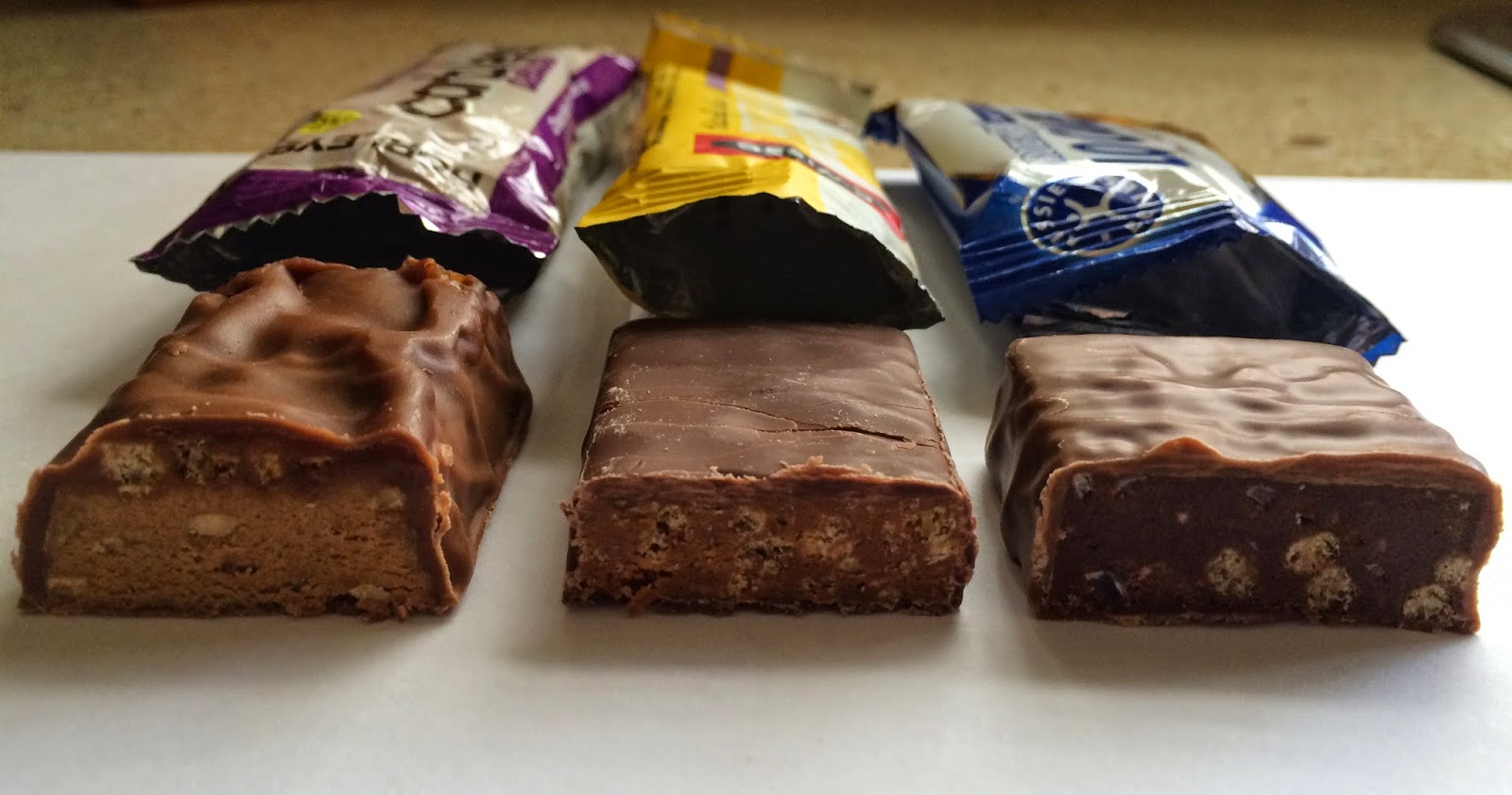Protein bars. The food alternative to protein shakes designed to help you gain muscle post resistance exercise. They aren't new, but they have cemented themselves into the health food aisle of supermarkets and chemists, not to mention gyms and health food stores. I decided it was high time I reviewed them, considering the ongoing popularity of my post 'lifting the lid on protein powder' last year.
Here I've picked three popular protein bars and compared them based on taste and nutrition.
What's actually in protein bars?
Protein bars come in many flavours but it's usually based around chocolate. The first ingredient in all three bars I looked at is protein blend at 30-40%. This is basically the protein 'powder' you can buy to turn into shakes. This is then followed by a long list of ingredients, many of which are long and difficult to pronounce (like polyglycerol esters of interesterified ricinoleic acid- um, what?). Chiefly, it's a mix of sugar (in it's many forms), chocolate, vegetable oil and additives like emulsifiers and flavours.
Protein comparison
Aussie Bodies Protein FX Lo Carb Mini Protein Bar (Choc Honeycomb)
9g protein/30g serve or 29.9g/100g
Swisse Low Carb Protein Bar (Choc/Caramel Flavour)
9.5g protein/25g serve or 37.9g/100g
Horleys Carb Less Deluxe (Chocolate Peanut Flavour)
10.1g protein/35g serve or 28.9g/100g
So, despite the Swisse bar coming out on top for protein per 100g, they are all roughly the same per serve. The bar sizes do vary, but lets face it: you're going to eat the amount that's in the packet, not leave a bite.
How do protein bars stack up against other protein containing foods?
- 1 chicken breast= 53.4g protein or 31g/100g
- 2 hard-boiled eggs= 11g protein or 12.4g/100g
- 250mL glass reduced fat milk= 10g protein or 4g/100mL
- 30g (small handful) mixed dry roasted nuts= 5.2g or 17.3g/100g
That means you could get the same amount of protein from a glass on milk, 2 hard-boiled eggs or 2 small handfuls of nuts. And meat is just off the scale…
Aussie Bodies Protein FX Lo Carb Mini Protein Bar (Choc Honeycomb)
A nice sweet flavour and very chewy. But still quite dry and with a powdery aftertaste.
Swisse Low Carb Protein Bar (Choc/Caramel Flavour)
Hard, dry and powdery plus a lack of flavour. Choc caramel: who knew? Definitely the worst.
Horleys Carb Less Deluxe (Chocolate Peanut Flavour)
A chewy centre, made softer by a layer of caramel. Nice flavour without the powdery texture of the other three. Could be mistaken for a chocolate bar but the clear winner in taste.
The verdict
Protein bars can be a convenient snack post work out, but they're also highly processed and expensive. With many everyday foods providing the same (if not more) protein per serve, like milk, eggs and nuts, I think there are much more nutritious options than these chocolate bars marketed under the guise of health. If you do choose a protein bar, I'd recommend combining it with a carbohydrate containing snack for the right muscle-building fuel. And choose well as some certainly taste better than others!
A nice sweet flavour and very chewy. But still quite dry and with a powdery aftertaste.
Swisse Low Carb Protein Bar (Choc/Caramel Flavour)
Hard, dry and powdery plus a lack of flavour. Choc caramel: who knew? Definitely the worst.
Horleys Carb Less Deluxe (Chocolate Peanut Flavour)
A chewy centre, made softer by a layer of caramel. Nice flavour without the powdery texture of the other three. Could be mistaken for a chocolate bar but the clear winner in taste.
The verdict
Protein bars can be a convenient snack post work out, but they're also highly processed and expensive. With many everyday foods providing the same (if not more) protein per serve, like milk, eggs and nuts, I think there are much more nutritious options than these chocolate bars marketed under the guise of health. If you do choose a protein bar, I'd recommend combining it with a carbohydrate containing snack for the right muscle-building fuel. And choose well as some certainly taste better than others!



This got me shredded right after I was lifting heavy, so now you can see my cuts more: https://www.drmaxpowers.com/15-day-cleanse.html
ReplyDeletei like multivitamin tablets organicindia
ReplyDeletethanks for posting
ReplyDeleteThanks for the blog about popular protein bars. Try superfoods, immune boosting food and nutrition bars for us too and experience the difference.
ReplyDelete